Conservation Tillage Fact
Sheet
| Fertilization in Dryland Cropping Systems: a brief overview |
| Merle F. Vigil - USDA-ARS, Akron, CO |
| A Brief Summary: of the amount of nitrogen (N) and phosphorus (P) required to maximize dryland crop yields. |
This is a brief summary of the amount of nitrogen (N) and phosphorous (P) required to maximize dryland crop yields. The values given are based on USDA-ARS research at Akron, CO, Mandan, ND and Land Grant college research in CO (CSU), KS (KSU), and NE (UNL).
The nutrients that are found to be most limiting in our region of the Central Great Plains are N and P. Occasionally, on very sandy soils with low organic matter, sulfur (S) and/or potassium (K) may be deficient. However, in a survey of farm soils tested from Western Kansas, Western Nebraska, and Eastern Colorado less than 1% were low in K.
Most of the soils in our region of the Great Plains are calcareous. These soils particularly on eroded hill tops will test low for available zinc (Zn) and iron (Fe). The deficiency is really a problem of high pH and shallow eroded soil. Attempts to correct the deficiency with soil applied Zn and Fe fertilizers are often unsuccessful because high soil pH in the eroded area chemically causes the added fertilizers to form insoluble iron and zinc minerals. Heavy applications of composted manure may be the best remedy but shallow soils may still limit crop rooting depths and subsequently crop yields.
We suspect that oilseed crops (sunflowers, canola, safflower) which have a higher S requirement than cereal grains (wheat, barley, corn, sorghum) may be S deficient in some soils. However, S deficiency has not yet been officially documented in Eastern Colorado. Table I shows the N and P required per bushel, or per 100 lb of grain for some typical dryland crops.
Table 1. N and P requirements of selected dryland crops grown in the Central Great Plains.
| Crop | N required* | P required (as P205)** |
| Wheat | 1.8 lb per bushel | 1.0 lb per bushel |
| Corn | 1.3 lb per bushel | 0.6 lb per bushel |
| Sorghum | 1.2 lb per bushel | 0.6 lb per bushel |
| Millet *** | 1.5 lb per bushel | 0.6 lb per bushel |
| Sunflower---confection | 7.0 lb/100 lb of grain | 1.0 lb per 100 lb of grain |
| Sunflower---oil | 6.5 lb/100 lb of grain | 1.0 lb per 100 lb of grain |
| Canola | 7.0 lb/100 lb of grain | 0.8 lb per 100 lb of grain |
| Forage Millet | 50 lb per ton of hay | 10 lb per ton of hay |
* N requirements were developed from experimental data collected by USDA-ARS at Akron, CO, Lincoln NE, and Mandan, ND, or University research from Kansas State Univ. (KSU), Univ. of Nebraska at Lincoln (UNL) and Colorado State Univ. (CSU).
** P requirements are taken from CSU research and the Western Fertilizer Handbook.
*** The N and P requirements for proso-millet (hershey) are our best guesses based on limited data.
How can the data in table 1 be used? The use of this data is best explained by an example. The following example is based on soil test information for available N as NO3-N and a "realistic" yield goal. A "realistic" yield goal can be calculated by taking the average yield of the last 5 crops grown on a field plus 5%. A 5 crop average is used to minimize the effects of extremely bad years, or unusually good years that are more the exception than the rule for a given field.
Example:
* Let's assume a soil test indicates that there are 30 lbs of available N per acre, in the surface 2 ft of soil, in the field of a farmer who wishes to grow wheat. Also assume the farmer's soil contains 1% organic matter.
* If the farmer's average yield for that field, over the last 5 crop years, was 45 bushel then the farmer could calculate a "realistic" yield goal by taking that average and adding 5% as follows:
45 bu +(45bu x 0.05) = 47.25 or 47.3 bu
where bu=bushels
* If we assume (from Table 1) that wheat needs 1.8 lb of N per bushel then his crop will require about 85 lbs of N.
1.8 1.8 x 47.3 = 85.1 lb of N required
* CSU soil testing laboratory assumes 30 lb of N will become available for every 1% of native soil organic matter. Recent work in Nebraska indicates the value may actually be between 20 and 60 lb of N per acre for every 1% soil organic matter (OM), but for simplicity let's stick with the 30 lb assumption.
* The amount of N needed by the crop as fertilizer is then:
85 lb -30 (from 1% soil OM) -30 (from residual NO3-N) = 25 lb of N as fertilizer.
* Most laboratories that make fertilizer recommendations, based on soil tests, incorporate an efficiency factor. The idea is that not all of the N applied is recovered and used by the crop. A good all around efficiency factor is about 55%. This value of 55% is debatable and will change with management (methods of fertilizer placement, fertilizer source, soil type, crop fertilized, etc.). However, if we use the 55% efficiency value, which probably isn't too far out of line, then:
251b N / 0.55 = 45.7 lb of N to apply as fertilizer
Sources of N and methods of placement: In general the source of N is not as important as the cost of the source and its ease of use. For example, anhydrous-ammonia (NH, gas) is the cheapest form of N on a per pound of nutrient basis. Even at $300/ton anhydrous ammonia is still cheaper per pound lb of N than urea-ammonium-nitrate (UAN, 28-32% N solution) or dry urea (46-0-0). On the other hand UAN-solution and dry urea are much easier to apply than anhydrous.
The method of placement is more important than the source of N. If anhydrous is knifed or bladed in at a very high rate (> 150 lbs actual N/acre), in a dry soil, at a very shallow depth (less than 6 inches) there will likely be some volatile loss of the N. In the same manner, if UAN solutions are applied broadcast to no-till stubble and the fertilizer is not incorporated by at least a third of an inch of rain, or by tillage and if this application is done during the warm days of summer volatile losses of the fertilizer will occur. The point is, regardless of the source, if the N is not applied carefully, volatile losses can occur. If applied correctly, N losses are minimal with either source.
Research (labeled N studies) in Kansas, Nebraska, Iowa and Colorado tends to show higher N recovery when the N is applied in "concentrated zones" as compared to broadcast applications. Nitrogen knifed below the soil surface, banded in a 2 by 2 placement from the seed, or dribbled on the soil surface is N applied in a concentrated zone.
Why are broadcast applications not as efficient? When N is applied broadcast it is mixed evenly with the soil and crop residues. Broadcast applications provide a greater opportunity for microbial tie-up of the fertilizer. Most folks don't realize that soil microbes will effectively compete with the crop for the N. If the N is applied in a concentrated zone only those microbes immediately adjacent to the zone of application will compete with the crop. Whereas, the crop's roots will grow to the concentrated zone of application and will even proliferate in that zone and therefore effectively recover the fertilizer N. The advantage a crop has over soil-microorganisms is its root system. Crop roots will effectively explore a soil and translocate needed nutrient back to the plant. Microorganisms can't do that as well as roots.
What about Phosphorous? Unfortunately, the "Yield goal" scheme used for N in the example above doesn't work quite as well for P. However, soil testing can help eliminate some of the guess work. In most cases, for soils that test greater than 8 ppm extractable P (using the AB-DTPA extraction method developed at CSU) P fertilizers will not be of benefit. That is, the addition of fertilizer P will probably not increase yields enough to pay for cost of the fertilizer. Soils that test between 4 and 8 ppm extractable P are considered marginally deficient. Fertilizer additions of 15 to 20 lbs of P as P20, are usually worth the cost of fertilizer. Soils that test less than 4 ppm extractable P are deficient. These soils should be fertilized with 30 to 40 lbs of P as P2 O5 and in most cases a yield increase from the added P fertilizer can be expected.
Sources of P and methods of placement: In general, on a per lb of actual nutrient 11-52-0 is as good as 10-34-0-solution or 18-46-0. The big advantage is that 11-52-0 is cheaper per lb of actual P than the other sources. However, as with UAN-solutions, 10-34-0 can be easier to handle then the dry sources. As with N, greater P recovery has been observed when P is applied in bands than when applied broadcast. If phosphorous is to be banded with the seed (which incidently is a good practice) then never apply more than 15 lbs of actual N as 11-52-0, 10-34-0 etc. or seedling injury could result. Remember that 15 lbs of N as 11-52-0 is 71 lbs of P as P205 which for most crops is more than enough P.
Some examples of N response: The yield increase from added N for several dryland crops grown on the same land (Weld silt loam), over several years, in a dryland-annual-cropping study was measured by Ardell Halvorson and Curt Ruele (Fig 1). That data indicates the optimum N rate is dependent on the crop grown, rainfall received, residual soil N levels, and with the previous crop's level of production. In 1984, initial soil test levels of residual soil N were high (120 lbs of available N in the top 4 ft of soil) and so the response to added fertilizer N was low (optimum N rate of about 30 lb). Consider the wheat yields and N response measured in 1988 (Fig 1). In 1988, 2500 lb of grain (42 bushel) was raised without any N fertilizer. The 1988 wheat crop was grown on corn ground that was hailed out in 1987. Since in 1987 no crop was removed from the field, much of the N in the hailed corn crop was returned to the soil (was left behind) for subsequent use in 1988. However, in 1988 50 lb of N fertilizer produced an additional 14 bushels of wheat. Even with $3 wheat, the cost of the additional fertilizer was worth it. On average the corn crops (1985 and 1989) have a higher optimum N rate (about 80 lb) than the small grain crops. In 1990, a dry year, combined with an assault by aphids greatly reduced yields. These graphs provide real estimates of N response in a dryland cropping system. They should not be used to make fertilizer recommendations for other fields, but provide an indication of what can be expected from N fertilizer for some of the crops, soils and climate of our region.
| Fig. 1. Yield response from N fertilizer measured in a dryland-annual-cropping study conducted at Akron, Colorado by USDA-ARS researchers Ardell Halvorson and Curt Reule. The symbols in each graph are the average grain yields for 4 replications. The dark line indicates the general trend of yield verses N application. The vertical dashed line indicates the N rate where yield was maximized. | |
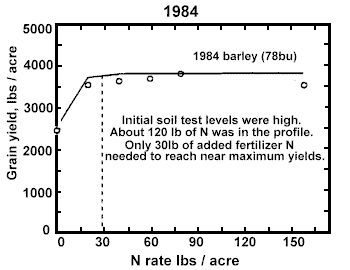 |
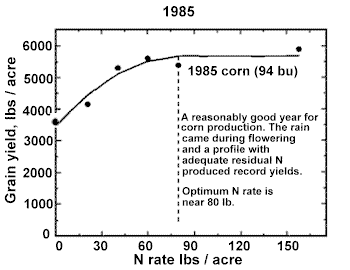 |
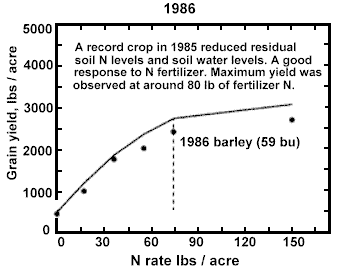 |
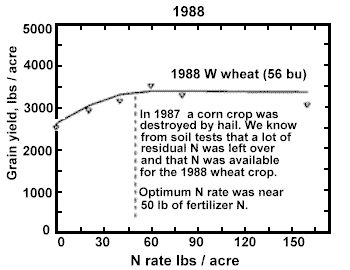 |
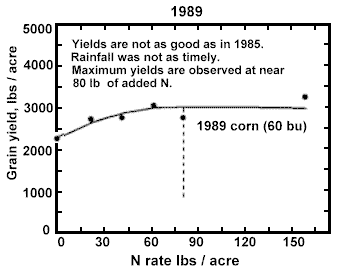 |
 |
- Conservation Tillage Fact Sheet #4-95. Published by USDA-ARS and USDA-NRCS.
- Merle F. Vigil (soil Scientist) USDA-ARS, Central Great Plains Research Station, Akron, Colorado.